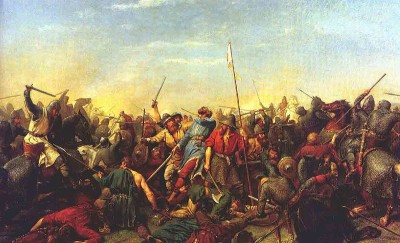Open Thread Thursday: The Wrong Side of History
I’m posting two “Open Thread Thursdays” topics this time to catch up a bit. The truth is, this one is essentially an edited repost. GeneaBloggers‘ prompt:
Over the next few years – with the sesquicentennial of the United States Civil War – there will be more of a focus on ancestors who fought in the conflict as well as those ancestors who supported certain causes and movements such as states’ rights or the abolition of slavery.
It is said that history is written by the winners. However, with the advent of blogging and the ability for almost anyone to have a platform where they can write and express their opinion, the stories of those on the losing side of these causes and movements are being told.
How do you handle telling such stories, especially if your ancestor was pro slavery or, for example, anti women’s suffrage? What if there is no evidence as to their opinions or positions yet they fought for the losing side in a war, such as World War II?
Is there, in fact, a “wrong side” of history?
~ ~ ~
“The Battle at Stamford Bridge”, painted in 1870 by Peter Nicolai Arbo, or as I wish I could call it, “27th Great-Grandpa’s Brother-in-Law”.
I enjoy an old Arthurian Romance now and then (“Eréc” is so close to “Eric” after all), a browse through the Norse Sagas, an occasional perusal of that original graphic history of 1066 called The Bayeux Tapestry, etc. But many are mixes of mythology and fact, or at least one-sided bias — usually a battle’s “winner”. Beyond enjoying the art of the texts and tapestries, deep down I just want to get down to what really happened.
Digging around in genealogical records is difficult when you get to the point where records stop being “parish and tax records and census of everyone” and start being “records for only those in power, church leaders, or occasional private collections,” usually only males. And when the published indexes of “official” records can also have errors or shifts in spellings, misinterpretation of ancient hand-written scrawls, or just glitches in following patronyms, it’s a head-scratcher sometimes.
So when I can trace a lineage from now to almost-then, and see the romanticized lineages of then, my Grail Quest senses get all riled up for wanting to find the hidden stuff between, regardless of what side “we” were on. But when I find a clue that there may be such “hidden stuff” that a previous chronicler skipped without reporting details… Argh!!
What I can say with a traceable certainty for this post’s examples, from parish records, farm probates, and such, is that one of my direct paternal 12th great-grandfathers (coincidentally named Eirik or Erik) had a son (Ole Eirikson) in 1480.
The problem going back farther for that particular branch, aside from the Black Death playing havok with 14th-Century European history, is the following footnote to published records, rough-translation and its emphasis mine:
For årbolken mellom Eirik Erlendson nr.60 og Erik nr.99 har en ikkje skrevne kjelder, men pålitelege beretninger frå mann til som har holt seg gjennom tidene og heilt fram til vor tid og kan trygt seiast å vere rett. Det skal vere 9 aetteledd melom Eirik nr.60 og Erik nr.99.
Langlo, Olav. Stranda Bygdebok III: Ættebok for Stranda. (Stranda [Norway]: Stranda Kommune, 1964), p.282, footnote 2.
[While annual records between Eirik Erlendson (#60) and Erik (#99) had not recorded the sources, reliable narratives from men who chronicled themselves through those times and held forward to our time can be safely said to be correct. That should verify nine generations between Eirik (#60) and Erik (#99).]
Nine generations of unsourced “reliable narratives” with no mentioned pointer of where to look for the records, nor any mention of what those nine names would be. Without those interim narratives, I can only wonder whether “Eirik Erlendson” is really my 22nd great-grandfather born about 1170.
And wonder I do, because the potential trail picks up again from there — possibly sourced from the Sagas:
Eirik Erlendson er soneson til Torberg, arnungeætt 34b.som er bror til erke-bispen Eystein i Nidaros. Oldemor deira er Jorun Torbergsd. Ho var dotter til Torberg Arneson og kona Astrid Erlingsd.fra Sola. arnungeætt 18.
Langlo, Olav. Stranda Bygdebok III: Ættebok for Stranda. (Stranda [Norway]: Stranda Kommune, 1964), p.282, footnote 1.
[Eirik Erlendson was a paternal grandson to Torberg (Giske clan history #34b), who was brother to Archbishop Eystein of Nidaros. Their great-grandmother was Jorun Torbergsdotter. She was daughter to Torberg Arneson and his wife Astrid Erlingsdotter of Sola (Giske clan history #18).]
Instead of having eyes glaze over from unrecognizable names, I’ll say that I do recognize some of these. Archbishop Eystein (also spelled Øystein) was a primary architect expanding the Nidaros Cathedral (aka Christchurch in Trondheim) and was exiled in England for a few years. For the other names, the Sagas themselves state (translated by others this time, but emphasis mine):
Ulf Uspakson stood in great esteem with King Harald; for he was a man of great understanding, clever in conversation, active and brave, and withal true and sincere. King Harald made Ulf his marshal, and married him to Jorun, Thorberg’s daughter, a sister of Harald’s wife, Thora. Ulf and Jorun’s children were Jon the Strong of Rasvol, and Brigida, mother of Sauda-Ulf, who was father of Peter Byrdar-Svein, father of Ulf Fly and Sigrid. Jon the Strong’s son was Erlend Himalde, father of Archbishop Eystein and his brothers. King Harald gave Ulf the marshal the rights of a lenderman and a fief of twelve marks income, besides a half-district in the Throndhjem land. Of this Stein Herdison speaks in his song about Ulf.
Sturluson, Snorri. Heimskringla: A History of the Norse Kings. Trans. Samuel Laing. (London: Norroena Society, 1907) “Saga of Harald Hardrade: Part I.” The Online Medival & Classical Library, “OMACL: Heimskringla” (http://omacl.org/Heimskringla/ : accessed 2011) — Emphasis mine
That link to King Harald (Hardråde, “Hardruler”) leads to the historically tumultuous 1066 (the year both Harald and Ulf died according to the Sagas), the Anglo-Saxon Chronicles, and the Tapestry. General highlights that English, Norwegian, and Norman/French history agree on:
- When King Edward “The Confessor” of England died in 1065, Harold Godwinson, Earl of Wessex, took the throne as King Harold II. But two others laid claim as well: King Harald of Norway and Duke William of Normandy.
- While Duke William gathered troops for a Normandy-to-England crossing, two hundred Viking warships led by Norwegian King Harald were met on the eastern shores of England by Earl Tostig — a brother of King Harold II — and together they burned Scarborough and sacked Fulford on the outskirts of York.
- While waiting with a gathering of hostages at Stamford Bridge, and not wearing armor in the meantime, Harald’s and Tostig’s troops themselves were pounced upon by Harold II’s men. Harald was killed by an arrow piercing his throat, and only about twenty warships returned to Norway on condition that the Viking invasions of England would cease.
- Tired and drawn out after an extended battle and rushing two weeks travel by foot, Harold II’s men then had to clash against Duke William’s troops at Hastings in an historic and epic Saxon failure, and victory for the Normans. Duke William gained the throne and was known thereafter as William “the Conqueror”.
So, one of my possible paternal 27th great-grandfathers (Ulf Uspakson, who hailed from Iceland and died in Norway before the invasion according to the Sagas) had a brother-in-law (King Harald Hardråde of Norway) that helped shape the control of England. My relation all comes down to 300-or-so-years of genealogical mystery. At this point centuries later, it doesn’t much matter to me to have been on one of the two losing sides, I’m just hungry for the details.
Of course, the Sagas themselves have vague source citations:
Some of this is found in ancient family registers, in which the pedigrees of kings and other personages of high birth are reckoned up, and part is written down after old songs and ballads which our forefathers had for their amusement. Now, although we cannot just say what truth there may be in these, yet we have the certainty that old and wise men held them to be true.
Sturluson, Snorri. Heimskringla: A History of the Norse Kings. Trans. Samuel Laing. (London: Norroena Society, 1907) “Preface of Snorre Sturlason.” The Online Medieval & Classical Library, “OMACL: Heimskringla” (http://omacl.org/Heimskringla/ : accessed 2011) — Emphasis mine
~ ~ ~
Now if I could just get cracking on the early-20th Century “Kaiser”-surname of the maternal German brick wall of the bloodline, which may be another story of the “wrong side” of history.




